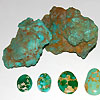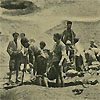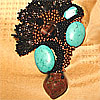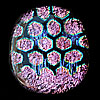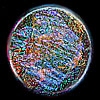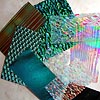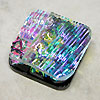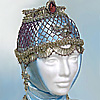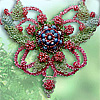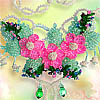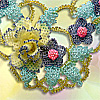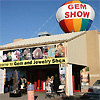December, 2009

Happy holidays!The holiday season is for family gatherings, fattening goodies, and flickering lights. Enjoy the season because before you know it, the year will be through. We love you all and wish you best of luck and happiness! Have a rest and enjoy your reading, in the final issue of our newsletter in 2009 year:
Turquoise in human history
Featured artist - Linda Roberts Creating dichroic glass cabochons Inspired by flowers New Year decorations Upcoming events Again, happy holidays!
MyLovelyBeads.com Team |
|
|
|
Turquoise in human historyDecember gem is turquoise. This gemstone played an important role in the development of the cultures in which it was utilized. The history of turquoise use in the Middle East and Egypt coincides with the beginning of civilization itself. Turquoise mining began in the Sinai Peninsula around 5500 BC. The stones taken from these mines served jewelry, amulet and cosmetic purposes for millennia. In 1900, archaeologists who excavated the tomb of the Egyptian Queen Zer (5500 BC) found a turquoise and gold bracelet on her wrist. That's the world oldest known example of surviving jewelry. In Persia archaeologists have found beads of turquoise that date around 5000 BC. Amulets from 600 AD contained carvings of Islamic and Persian Proverbs. The fine stones from this area were important sources of trade and were found in graves as far away as Turkestan and the Caucasus. These revered stones, so important to the Persian culture, were called Ferozah, which meant victorious. In modern times, Iran honors turquoise as its national gemstone. The earliest Anasazi peoples in Pre-Columbian America had opened their turquoise mines by 1000 AD and had established extensive trading practices with the peoples of what is now Mexico. The mining locations included locations in Arizona, New Mexico and Colorado. In cities such as Chaco Canyon, the Anasazi traded their turquoise for the feathers of tropical birds. As demand for the Anasazi turquoise grew in the south, the society at Chaco Canyon grew wealthy. The ancient Turquoise jewelry of the Zuni tribes was characterized by prominent inserts of the stone. Navajo Turquoise jewelry features die-stamped designs. In the 16th century, the cultures of the American Southwest used turquoise as currency. It was also often found on the facades of Indian homes. Aztec turquoise mines began operating between 900-1000 AD. As to Asia, by the middle of the first millennium, AD, China had begun using turquoise and although they had mines in their empire, they imported most of their stones from Persians, the Turks, the Tibetans and Mongols. Japan use of Turquoise began in the 18th Century AD. Around 500 BC, inhabitants in Siberia had also begun using the stone, but it did not gain favor with Western European fashion until the late middle ages when trade with the Near and Middle East had increased. The origin of the word Turquoise is French and comes from Venetian traders, who bought it from the great bazaars in Turkey, though the Turkish traders brought it from the Persian mines. Shakespeare's "The Merchant of Venice" features a turquoise ring. The Aesthetic Period (1880-1901) responded to the strict provisions of Queen Victoria's mourning and jewelry became more whimsical. Turquoise played a large role in the jewelry of this period but played an even greater role during the Romantic Period (1837 to 1860). The light gold worked jewelry of this period contained fine gems that were often accented by turquoise. |
|
Featured artist - Linda Roberts
Dichroic glass artist Linda Roberts lives in San Diego, California, USA. She is a self taught artist using books, magazines and DVD's to teach herself bead stringing, beadweaving, bead embroidery and jewelry design. She has taken classes in PMC (precious metal clay), polymer clay, stone cabochons, wire wrapping, silversmithing, lampworked glass beads, and glass fusion. Linda says, "My route to creating jewelry actually started with my love of rocks and stones. After collecting many beautiful rocks, I wanted to know more about them so I joined the San Diego Gem and Mineral Society and a whole new world opened up to me. While attending many different gem and mineral shows I was awed by all the beautiful handcrafted pieces of jewelry I saw. It was at one of these shows that I discovered dichroic glass. My love for beads developed gradually, beginning about 10 years ago. At first I was hesitant to express my fascination with them, but the beads won and I'm now an admitted beadaholic with no hope or desire for recovery. It is very fulfilling to encircle my treasured stone and glass cabochons with tiny seed beads and create unique jewelry. In June 2009 I attended a local bead show and was looking for dichroic glass cabochons to use in my beadweaving. I met Paul Fernandes, owner of Fusionglass Co. in La Mesa, CA. He told me about the glass fusion classes they offered at their store and I knew it was something I had to do! The class was taught by his partner, Debbie Solan, and it was so much fun. In just a couple hours I had designed three potential cabs. Normally the store fuses the glass in their kilns and the students return in two days to pick up their cabs. But I was determined to learn how to do the whole process myself. I had an older (but hardly used) kiln at home just waiting for some action. My Sierra kiln was not specifically made for glass but actually works very well. It has three built in programs for PMC and one program that can be set by the user. I was given a guide sheet for fusing the glass from the class instructor, but it had eight different settings and I could only program in four settings. I did a lot of research on the internet and found a few helpful articles... ...I had also saved an article out of a magazine (sorry, I do not recall which one) called "Two-Timing Kiln" by Kathleen Bolan that addressed how to specifically program my kiln for annealing glass beads. To properly fuse and anneal glass, the kiln must be ramped up or down to different temperatures, at different rates, and held at these temperatures for different periods of time. If the glass is cooled too quickly it will not anneal properly and will potentially crack."
The full article by Linda Roberts on her art
|
|
Creating dichroic glass cabochonsDichroic glass is glass containing multiple micro-layers of metal oxides which give the glass dichroic optical properties. The process of cutting and preparing the glass is quite simple. The basic tools and materials required can be purchased from a stained glass supplier or a ceramic supply store that is involved with fusing:
• glasscutter - this puts a "scratch" on the glass where it is to be
broken;
• pliers - special curved pliers that when placed over the "scratch" break the glass along that line; • grinder - used to shape the glass (I use a flat top Hi-Tech Diamond Grinder); bit rotary grinders are useful for creating curves; • glass - must be compatible meaning it must have the same COE (Coefficient of Expansion); I use COE 90 glass. The glass is prepared in layers of two to four different types and colors of glass. Because of its reflective properties, dichroic glass often will only show its brilliant colors when placed on top of black, so a black glass backing is often used. Dichroic glass can be purchased layered on black glass or on clear glass. This allows for a lot of variety and unusual results. You begin by making a backing. Take a piece of black glass (or dichroic glass already placed on black glass) and cut it to the size you want using the glasscutters and pliers. If you want the corners rounded, you can use the flat grinder to round them. Once you have the backing glass sized and shaped like you want, choose the dichroic glass you want for your second layer. You can use many different kinds and colors of glass placed next to each other or one specific type of dichroic glass for the whole 2nd layer. This is where your creativity and imagination come into play. The top layer is either another piece of dichroic glass layered on clear glass or just plain clear glass. If dichroic glass is placed on top, the finish will be metallic. If clear glass is used, the finish will be shiny glass. The full article on creating dichroic glass cabochons by Linda Roberts |
|
Inspired by flowers
This month's featured artist comes from Russia, her name is Irina Belinskaya, she is a Muscovite. As a child Irina was interested in portrait painting and her dream was to become an artist. She spent most of her spare time drawing, till the day she found beads in her mothers crafting box. She asked her mother to let her take the beads and give beading a try. Irina didn't have any kind of special tools for beading, she pulled string thru beads by gluing the ends, it was not the easiest way to work but soon Irina made her first bead necklace from one of the crafting magazines. The necklace turned out beautiful and she received many compliments from her family and relatives, however Irina decided not to continue beading. Following her parent's advice Irina went to college and got a degree in banking, never returning to beading until 90's. Toward the end of 90's Irina saw an Ad in newspaper for a beading class. Irina remembered her first necklace and decided to take the class, shortly after starting classes Irina decided that she didn't want to spend days copying designs and beading, she wanted to create her own jewelry. After few months Irina left her job in banking industry and started her career as jewelry designer. Some of her first designs were bead woven women's caps, she created for the Golden Ring Fashion Shop. Shortly after Irina became a member of Modern Beading Moscow Club headed by Galina Pchelkina, a talented bead worker and instructor. Irina worked with other bead artists and exchanged knowledge and experience till she started working with Amber Orchid Jewelry Company as a designer and has designed numerous items using seed beads and amber. From there Irina's popularity grew and her customer base expanded outside of Russia to USA, Germany, France, Spain, Italy, Denmark, Croatia, Finland, Switzerland, and numerous other countries. Irina loved designing beautiful necklaces for her customers, but there was one item that she has always wanted to make. Firebird Necklace, it was her dream to feature a firebird from a Russian folk tale, however she was not able to design it the way she wanted. Till one morning she woke up with an image of how here masterpiece necklace should look like, she put aside all other work and started and finished her Firebird Necklace. Irina works with different techniques and color combinations, depending on project at hand. Her main sources of inspiration are flowers. She features flowers in a lot of her designs, especially roses which are as she says it her Muse. Irina participates in many jewelry and beading contests, she has a permanent display at the Nagornaya Art Gallery in Moscow. Her beadwork is featured all over the world, in fashion magazines and catalogs. She is a proud member of the Creative Union of Russian Artists, the Moscow branch of the Artists' Society, and the International Federation of Artists.
Bead artwork by Irina Belinskaya
|
|
New Year decorations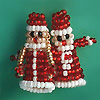
This small tutorial (not step-by-step, but patterns and pictures) by Victoria Katamashvili is about New Year decorations. Altogether with patterns, photos, and beadwork samples it seems to be pretty simple. Decorate your holidays! |
|
Upcoming events
January 29 - February 09, 10, 2010 J.O.G.S. Gem and Jewelry Show is the largest and most popular independent jewelry trade show in the Tucson, Arizona area. Wholesale jewelry manufacturers, miners and international dealers gather in Tucson every winter. Each J.O.G.S. show is held in the state of the art Tucson Expo Center, one of Tucson's largest professional convention centers. The whole show takes place under one roof and on the same floor, ensuring that buyers visit every booth and no vendor gets left out. Great promotion, a complimentary lunch buffet for the buyers, top security and a red carpet atmosphere has been responsible for the success of the J.O.G.S. show. This year specials:
• more than 146 classes include wire wrapping and beading classes, fine macrame, PMC classes
• exhibition of unique jewelry made by internationally recognized jewelry designers • presentation of the new Mixed Media. Jewelry Techniques Book
A few pictures from J.O.G.S. Gem & Jewelry Show 2009
|
|
Note
If you don't see the newsletter properly formatted please click here:
December Issue
|
© 2010 MyLovelyBeads.com All Rights Reserved.
If you do not want receive our newsletter and you wish to remove your email address from our mailing list, please click the following link to unsubscribe.



